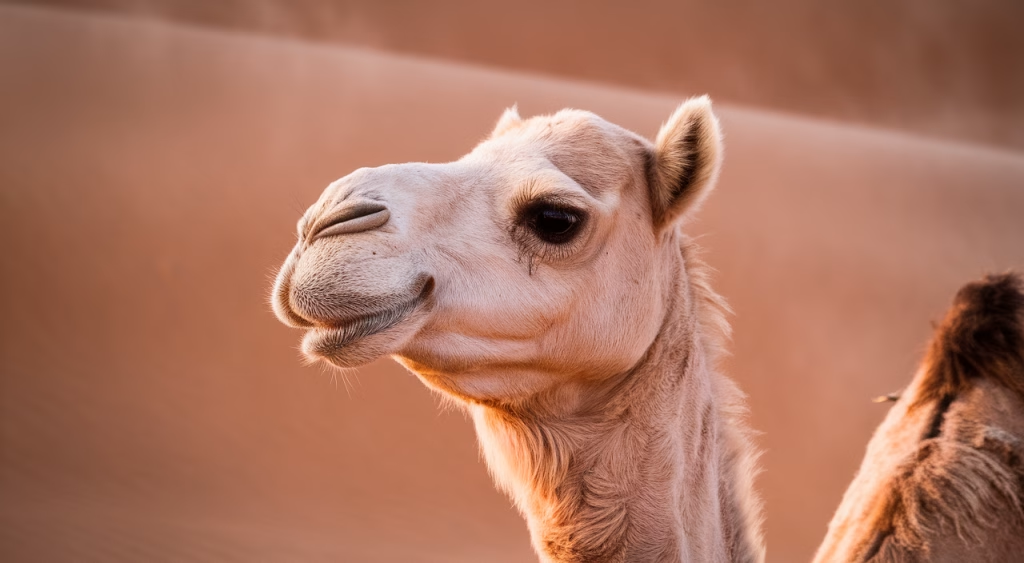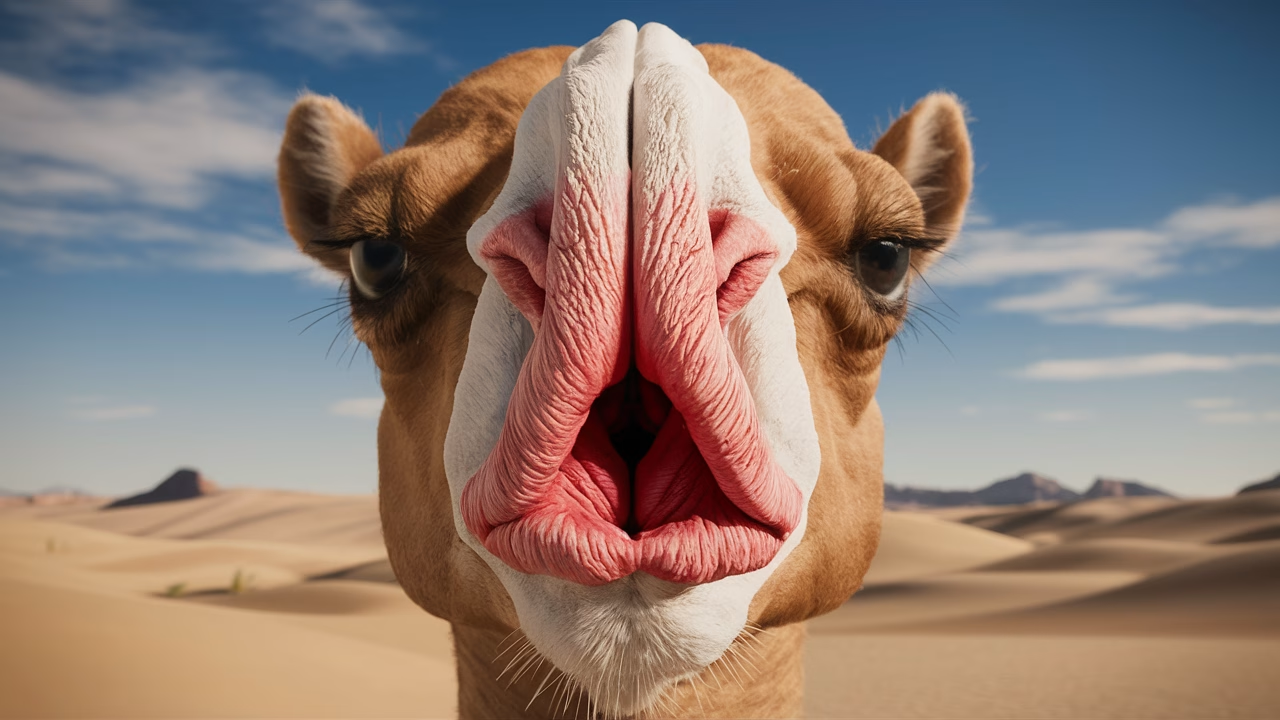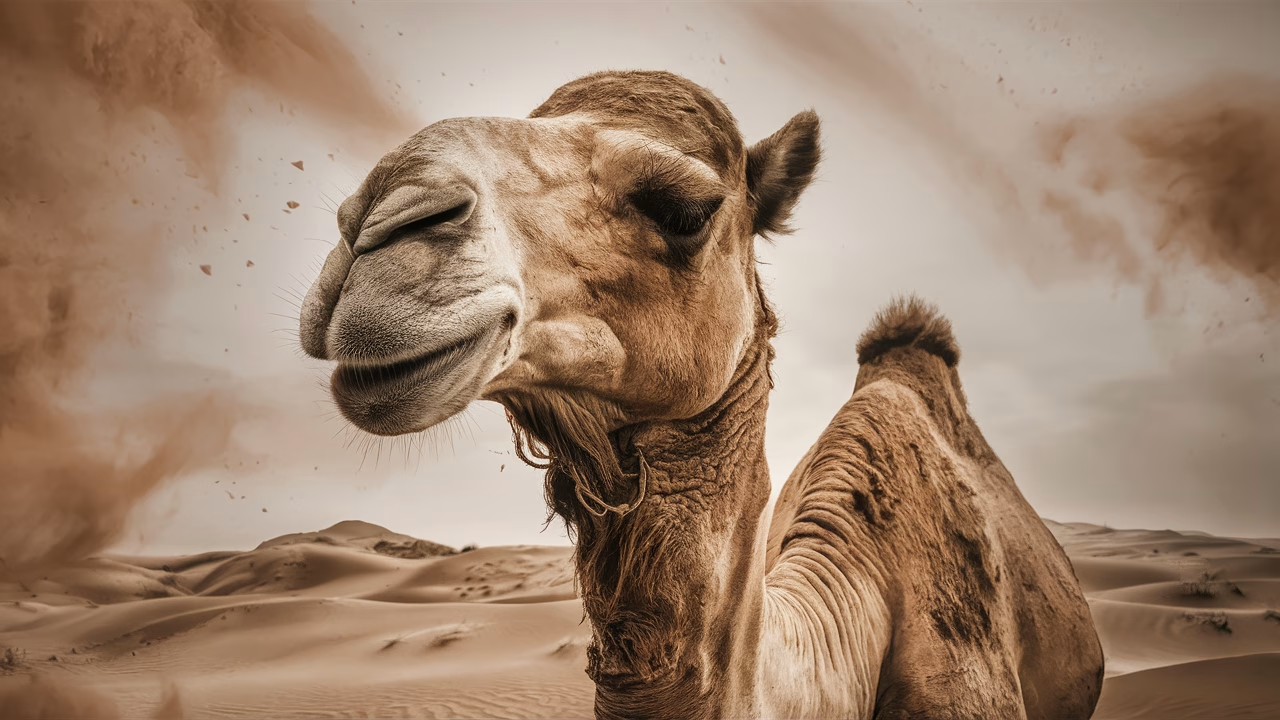How do camels prevent sand from entering their noses?
Camels prevent sand from entering their noses thanks to their uniquely adapted nostrils, which can close completely to seal out airborne particles. Combined with other desert adaptations—like long eyelashes and a specialized respiratory system—these camel nostrils allow them to thrive in harsh, arid environments where sandstorms pose a constant threat to survival.
TL;DR: Camel Nostrils Are Nature’s Sand Shields
- Primary Function: Camel nostrils can clamp shut during sandstorms, providing complete sand protection.
- Anatomical Benefit: Slit-like openings and muscular control enable dynamic nostril movement for desert adaptation.
- Physiological Bonus: Moist inner linings help trap fine dust particles before they enter the respiratory system.
- Adaptation Context: Evolved over millions of years through evolutionary pressure for improved desert survival.
- Complementary Traits: Long eyelashes, thick eyebrows, and dense nasal hairs enhance overall sand protection.
Anatomy of Camel Nostrils: Understanding the Mechanism
Slits With Purpose: Musculature and Mobility
When you observe a camel’s face up close, one feature stands out beyond the humped posture and wide-set eyes—their remarkable, slit-like camel nostrils. These aren’t just aesthetic features. They serve as biological fortresses, strategically engineered through desert adaptation to manage the harsh challenges of arid environments. The nostrils are controlled by strong levator and depressor muscles, giving camels extraordinary control: they can open or close their nostrils at will for optimal sand protection.
During a sandstorm or when strong desert winds whip sand across the dunes, these muscles provide instant defense. The camel nostrils close tightly, forming a barrier that completely seals their respiratory system. Unlike human nostrils—which remain constantly open and vulnerable—a camel’s nose actively defends against environmental threats. It’s nature’s version of a submarine hatch sealing tight before the storm strikes.
Internal Architecture: Slowed Airflow and Filtration
Inside the nasal cavity, the camel anatomy becomes even more fascinating. Camels possess a complex turbinate structure—bony ridges within the nasal chamber that dramatically increase surface area. These specialized features help moisturize incoming air while trapping fine dust particles and cooling air before it reaches the respiratory system. The inner lining contains sticky mucus membranes and dense nasal hairs that work together, creating a sophisticated filtration network comparable to a multi-stage air purifier.
Evolutionary Significance: How Desert Environment Shaped Camel Respiratory System
Let’s explore the evolutionary journey. Picture ancient landscapes ruled by scorching days, bone-dry nights, and sudden sand surges—the unforgiving desert environment that shaped camel survival. Over millennia, evolutionary pressure sculpted the camel respiratory system into a masterpiece of desert adaptation. These specialized camel nostrils aren’t random features; they represent evolutionary innovation refined by the elemental forces of aridity, heat, and windborne sand.
Natural selection operates by favoring traits that enhance survival and reproduction in specific environments. Ancient camels with superior nasal closure or more efficient sand protection systems were more likely to avoid respiratory infections, airway blockages, and dehydration from sand ingestion. Over countless generations, these advantageous traits accumulated, preserving genes that produced increasingly effective camel anatomy for desert survival.
Remarkably, this respiratory system adaptation didn’t evolve in isolation. It co-evolved alongside complementary features like long eyelashes, thick protective eyebrows, and specialized water conservation mechanisms through nostril-controlled exhalation. The entire camel facial structure represents an integrated biomechanical toolkit, forged by eons of environmental challenges—a comprehensive evolutionary response to one fundamental survival problem: maintaining clear airways while preventing sand entry.
Practical Implications: Survival Strategies in Arid Regions
Understanding these desert adaptations provides fascinating insights for nature enthusiasts, biology students, and wildlife researchers. The remarkable sand protection capabilities of camel nostrils demonstrate how specialized anatomical features can determine survival success in extreme environments. A camel’s nostril closure ability delivers multiple critical advantages for desert survival:
| Function | Benefit in Desert |
|---|---|
| Nostril closure | Complete sand protection during storms |
| Moisturizing mucus | Traps particles and conserves precious moisture |
| Turbinate bones | Cools and filters air entering respiratory system |
| Long eyelashes | Reduces airborne debris reaching sensitive areas |
Even more impressive, these specialized camel nostrils contribute significantly to water conservation—a critical desert adaptation. As exhaled air passes through the nasal passages, moisture condenses on the turbinate surfaces and gets reabsorbed, minimizing precious water loss. This respiratory system performs dual functions, serving as both environmental protector and resource preserver for optimal desert survival.
Conclusion: The Ingenious Design of Camel Nostrils
Survival in Every Breath
The next time you observe a camel, whether in the wild, a sanctuary, or a captivating wildlife documentary, take a moment to appreciate the remarkable engineering above its lips. Those distinctive slit-like camel nostrils represent far more than biological curiosities—they’re the product of 50 million years of evolutionary problem-solving and desert adaptation. They seal like precision-engineered doors during sandstorms, function as sophisticated air filtration systems, and contribute enormously to the camel’s superior resilience among desert creatures.
At both molecular and mechanical levels, camel nostrils demonstrate how perfectly function follows form in nature’s designs. They represent evolution’s desert technology—zero maintenance required, maximum efficiency achieved. As we continue studying and appreciating remarkable animal adaptations, the camel’s specialized respiratory system serves as a powerful reminder: sometimes nature’s most profound innovations are found in the smallest, quietest, and most elegantly efficient solutions to environmental challenges.
Frequently Asked Questions
How do camels keep sand out of their noses?
Through voluntary muscle control, camels can completely close their camel nostrils, preventing sand entry during desert storms. Internal filters including mucus and nasal hairs provide additional sand protection by trapping any particles that might enter.
What other features help camels survive sandstorms?
Beyond closable camel nostrils, these desert adaptations include long eyelashes, thick protective eyebrows, and double rows of eyelashes that deflect blowing sand away from sensitive eyes and respiratory system openings.
Do other animals have similar nasal adaptations?
Some desert animals, like fennec foxes, have narrow nostrils and basic nasal filters, but the camel’s ability to completely seal their camel nostrils represents a unique and more advanced desert adaptation for sand protection.
Can camels breathe through their mouths?
Yes, but camels strongly prefer nasal breathing, especially in desert environments where their specialized respiratory system preconditions air for optimal hydration and filtration. Mouth breathing increases water loss significantly.
What happens inside the camel’s nose when it closes?
When camel nostrils close, the nasal passage contracts completely, creating an airtight seal. Internally, mucus continues trapping any remaining dust particles, while the air gets humidified and filtered through specialized turbinates before reaching the respiratory system.
How did camel nostrils evolve?
Through generations of evolutionary pressure and natural selection in desert environments, camels with superior nostril closure and sand protection abilities had better survival rates. This led to the advanced camel anatomy and specialized respiratory system adaptations we observe today.





